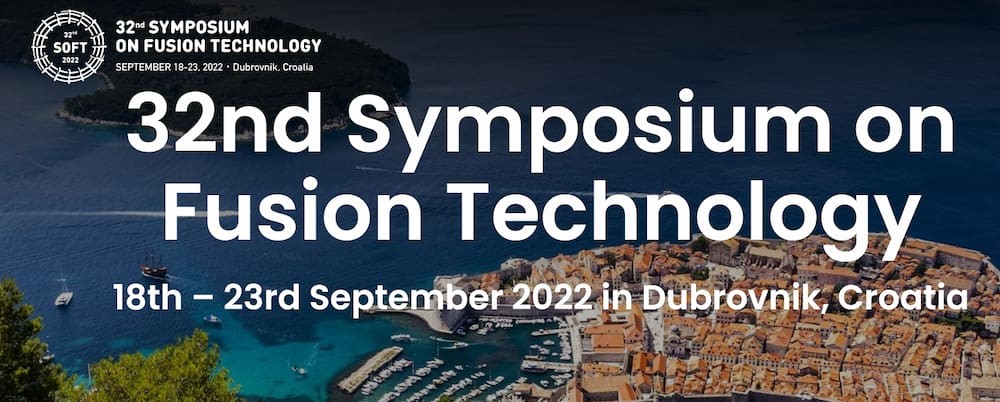 News
News
32nd SOFT Conference 2022 18-23 September Dubrovnik (Croatia)
On 18-23 September 2022 the Croatian city of Dubrovnik provided a magnificent setting for the 32nd Symposium on Fusion Technology (SOFT 2022), the most prestigious conference in this field in Europe with a thousand world leaders from science and industry, and important personalities in the fusion research from all over the world, who discussed the most important innovations in the field of nuclear fusion. In this context, the University of Tuscia was present at the event with 6 PhD students, who presented their research activities during poster sessions over the 6 days.
During the conference the participants had the possibility to listen interesting talks of several key fusion experts as Alain Becoulet (Engineering Domain Head of ITER Organization), Pietro Barabaschi (new Director-General of ITER), Francesco Romanelli (Chairman of the BoD of DTT s.c.a.r.l.), Gianfranco Federici (head of EUROfusion technology department) and Tom Barret (technical leader of CHIMERA project, UKAEA). “It was so nice to sit around the table again with colleagues and discuss in the hallways the things that really matter, that make us want to work together, and that help us move things forward,” said Dr Tony Donné, Programme Manager of the EUROfusion Consortium, whose presentation on “Navigating along the fusion roadmap” was the most viewed online. During the days of the conference, participants had the pleasure of visiting the magnificent old town of Dubrovnik, set of the famous TV series “Game of Throne”.
From University of Tuscia different topics are exposed during the poster sessions. Six posters were presented. Below the main arguments are reported.
The first topic concerns the sacrificial limiters used inside nuclear fusion machine. Three different posters are relative to them.
Towards the demonstration of fusion energy, the greatest challenges may arise from the need of strongly mitigating the degradation of conventional breeding blanket first wall modules during plasma transients and disruptions. Within the EUROfusion DEMO research activities, first wall limiters are envisaged as the last protection resource of the otherwise un-shadowed rector wall. In this context, optimized layouts of the plasma-facing units of such components were developed, equipped with innovative tungsten metamaterials as sacrificial armours able to meet the conflicting requirements of the limiters. Additive manufacturing was successfully employed to produce lattice samples for material characterization and testing, currently ongoing.
The second work concerns the development of a parametric model to identify the optimized component configurations to be considered for the sacrificial limiter, in order to maximize its functional effectiveness, by scanning all possible combinations of relevant parameters. The identification of possible configurations was followed by a preliminary study through Computational Fluid Dynamics of the thermo-hydraulic behaviour of the plasma-facing-component cooling circuit, satisfying the total pressure drop requirement for its potential integration.
The third work concerns the development of a 3D finite element model to analyse in depth the influence of the actual features of latticed metamaterial on the overall performance of the DEMO limiter, based on a flat tile configuration. Its main goal is to identify the most promising layout as pre-conceptual design for the fabrication of a small-scale mock-up. The model allowed to perform coupled thermos-mechanical analyses with regard to the loading conditions that develop during different plasma scenarios and allowed to verify structural integrity of the component through acceptance criteria established for ITER in-vessel components.
The fourth work presents a disruptions database analysis aimed at characterizing off-normal plasma scenarios in ST40 2021-2022 experimental campaign. In this context, to support the Spherical Tokamak ST40 operations, effects associated with disruptions have been investigated. To define a safe operational space, disruption numerical simulations have been performed with the aim to reconstruct the plasma dynamic behaviours by using MAXFEA for a better calibration of the code, starting from experimental data.
The fifth work aims to define the structural behaviour of ST40 Inner Vacuum Chamber (IVC2) under the action of electromagnetic loads. The analysis was carried out considering the entire ST40 mesh model with high degree of detail allowing to accurately approximate its real behaviour. The completeness of the model has guaranteed to study the global ST40 stress state with a focus on the local stress state generated on the IVC2 and on all the components that weigh on it.
The last work deals with the verification of the structural integrity of the Divertor Tokamak Test (DTT) vacuum vessel against loads associated to several machine operating states. A large campaign of thermo-structural analyses has been carried out on a very detailed FE model of the vessel to assess the actual design and to improve it where needed. The stresses over the vessel comply with the limits suggested by the principle standards.